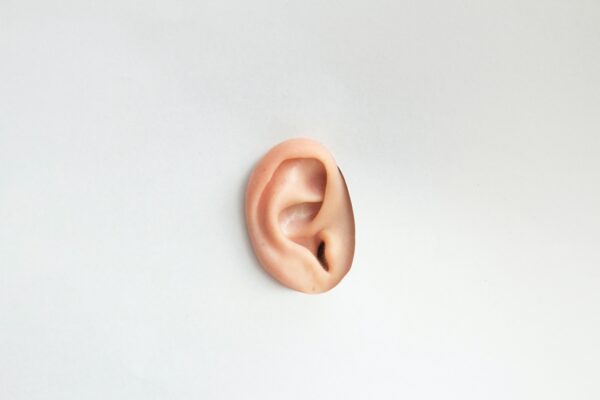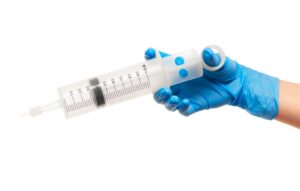Struggling with hearing? Request a hearing test appointment today.

Are you experiencing pain after ear irrigation? You may be feeling muffled hearing, throbbing or soreness. These are common side effects of ear syringing. At Regain Hearing Clinic, we use microsuction as our preferred choice of ear wax removal as there are fewer complications and common problems associated vs traditional ear syringing.
In this post, we will explain how ear syringing works and the associated side effects of ear syringing you should be aware of so that you can decide if it is the best method of ear wax removal for you.
Five Side Effects of Ear Syringing or ‘Ear Flushing’
Most people tolerate ear syringing with water without any issues. If you have any side effects from this procedure, they are usually mild.
The five most common side effects of ear syringing are:
- Dizziness — a common side effect; this will normally settle down within a few hours.
- Inflammation — can occur in the ear canal after an ear syringing procedure, which may feel itchy and uncomfortable.
- Ear Infection — although it is uncommon, there is a slight possibility of an ear infection following ear syringing, which may be painful and cause discharge from the ear.
- Ear Damage or injury — there is a small possibility the ear canal or ear drum could sustain some injury. This may result in a perforated eardrum in rare instances.
- Hearing loss — in extremely rare cases, there is a possible chance of short-term hearing loss, muffled hearing or deafness.
Ear syringing is also a common procedure in the UK. ‘Recent estimates suggest that up to 2 million ear irrigations are performed in England and Wales each year.’ Grossan M. Cerumen removal — current challenges. Ear Nose Throat J.
Do your ears still feel blocked after ear wax removal? Here’s what to do.
If you experience any of the above side effects and they don’t improve or seem to be getting worse, contact your GP or an experienced audiologist. You may need antibiotics if you have an ear infection or surgery if you have sustained a perforated eardrum.
- Do your ears still feel blocked after wax removal?
- Have you noticed that you need to turn up the volume to hear clearly when watching TV or listening to the radio or music?
- Or are you finding it difficult to catch every word when having a conversation?
- Do you have throbbing ear pain?
If the answer is yes to any of these questions, you could still have ear wax build-up.
It is important to speak with your GP, who can check your ears for signs of infection or other problems, such as perforated ear drums. Your GP may refer you to a specialist audiology service for ear wax removal if you meet specific criteria.
Ear syringing is normally the first method used to remove ear wax blockages when you are treated by an NHS audiology service.
This may be followed by microsuction ear wax removal if you are still experiencing problems after a couple of weeks. Many people don’t meet the criteria or face a long wait to get an appointment once referred by their GP and choose to pay for private ear wax removal at a hearing clinic.
What’s Ear Syringing?
Ear syringing with water is sometimes referred to as ear irrigation. It is a standard procedure used to remove built-up ear wax or foreign things (such as insects) from the ear. The process involves warm water being carefully squirted into the opening in your ear. The water pressure is then used to dislodge stubborn ear wax in your ear canal.
The wax becomes detached because of this process and comes out with the water. Syringing is normally the initial technique used to remove ear wax if your GP refers you to an NHS audiology service.
How Do I Know if My Ears Need Syringing?
There are various signs that may indicate an ear wax blockage. Common signs you might need to have ear wax removed include:
- Diminished hearing
- Pain in or earache
- A feeling of fullness in your ear
- Buzzing or ringing sounds (tinnitus)
- Dizziness or vertigo
- Ear drainage
- Unpleasant odour coming from your ear
- Itching or irritation in your ear.
Is Ear Syringing Safe?
Ear syringing with water is a safe method. However, we only advise using it for clearing soft ear wax. The eardrum can be damaged if the ear wax is hard. In this case, we’ll advise a different ear wax removal technique, such as microsuction ear wax removal. Additionally, if you have previously experienced difficulties from this procedure, ear syringing is not advised.
There are some contraindications for ear syringing with water. You shouldn’t have this procedure if you have:
- A perforated eardrum, or have had one in the past
- Grommets already in place or recently extruded (within the last 18 months)
- Surgery on the middle ear or ear canal
- Ear discharge with any fluid within the previous year
- A cleft palate (whether or not it has been fixed)
- Acute otitis externa of the pinna (redness and inflammation of the ear canal )
- Otalgia (ear pain) or have a history of ear ache or pain
- An ear infection or have had one within the previous six weeks.
Ear Syringing vs Microsuction
Ear syringing and microsuction are the two common methods used to remove a build-up of ear wax. The difference between these two techniques is ear syringing requires water, whereas microsuction is performed with a suction device and does not use water.
If any contraindications prevent you from having safe ear syringing, microsuction ear wax removal can normally be performed. Many people prefer this method of ear wax removal as it is generally more comfortable, less messy and there is a lower risk of infection or damage to the eardrum.
What do our Audiologists say?

FAQ
Can syringing ears cause damage?
Ear syringing, or ear irrigation, is a common procedure used to remove excess earwax, but it must be performed correctly to avoid potential harm. If done improperly, syringing can lead to several complications, such as ear infections, eardrum perforation, or damage to the ear canal. It’s crucial that the water temperature is carefully controlled to prevent dizziness or vertigo, and the procedure should not be performed if there is a history of eardrum perforation or current ear infection.
How long does it take for ears to settle after syringing?
After ear syringing, it typically takes a few hours for your ears to settle. However, some individuals might experience symptoms such as slight discomfort, dizziness, or tinnitus for a short period afterward. These symptoms usually resolve within 24 hours. If you continue to experience discomfort or other symptoms beyond this period, it’s advisable to consult a healthcare professional to ensure there are no complications such as residual water or wax in the ear canal, or in rare cases, an ear infection.
How often should I have ear wax syringing?
Ear wax syringing should only be performed if ear wax removal drops have not been effective. Typically you shouldn’t need to have it done more than once a year. However, it is safe to have it done more often. If you produce a lot of ear wax or have narrow ear canals, you may need to have it every three to six months.
Is ear syringing painful?
Ear syringing should never be painful. However, you may find the sensation of water being squirted into your ear canal uncomfortable.
If you have any concerns about hearing loss, at Regain Hearing we offer the most advanced microsuction ear wax removal in Kent and London performed by qualified audiologists. Please call or fill in our form to arrange a ear wax removal at our Regain Hearing clinics in London, Kent and Essex.

